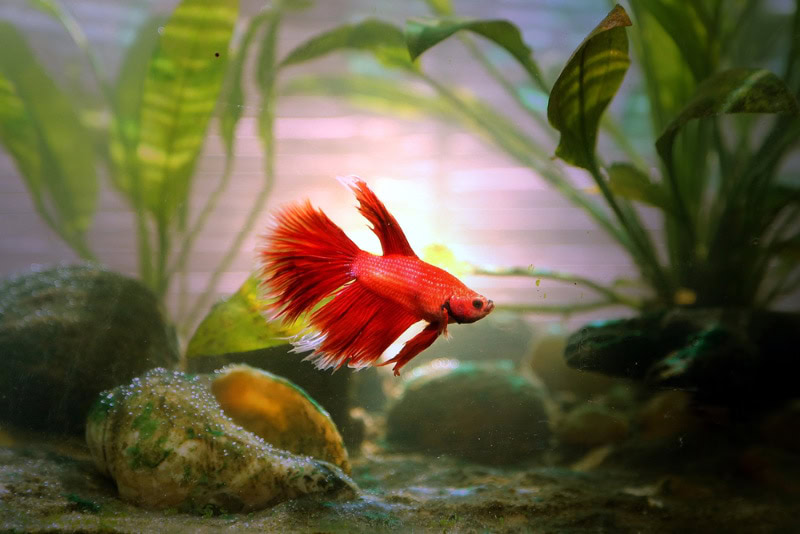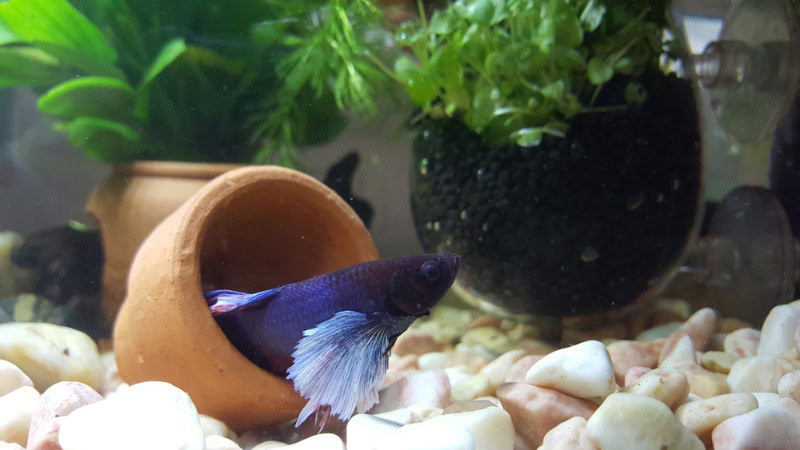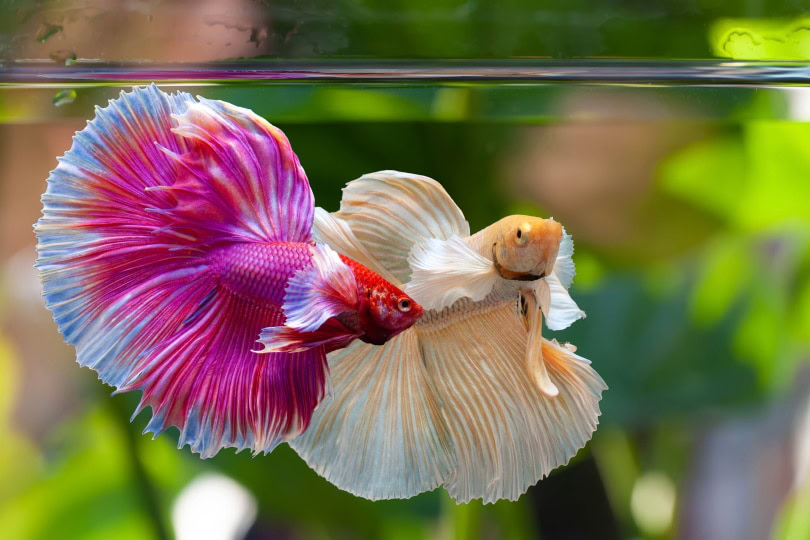VET APPROVED

The information is current and up-to-date in accordance with the latest veterinarian research.
Learn more »Click to Skip Ahead
The Betta fish (Betta splendens, also known as Siamese fighting fish) is a popular pet for fish enthusiasts because of their beautiful color variations and easy upkeep. Bettas belong to the Anabantoid suborder of fish, which all have a special biological addition that helps them survive.
If you’ve considered getting a Betta fish (or already have one) as a pet, you might wonder whether they need specialized tank equipment. Luckily, Betta fish don’t need air pumps or bubblers in their tank because of the specialized organ we mentioned; read on to discover what your Betta will need and how they use their labyrinth organs to survive.

Why Do Betta Fish Not Need Air Pumps and Bubblers?
Betta fish (along with other Anabantoid fish) have labyrinth organs, which help them take in atmospheric oxygen from the water’s surface. The amazing aspect of these bony organs is that they’re designed to breathe air, meaning the Betta can breathe air from the surface. Alongside their gills, which filter oxygen from the water (like regular fish do), the Bettas periodically surface and gulp air. This adaptation helps them survive in stagnant, warm bodies of water (which are very low in dissolved oxygen).
Bettas actually do have to surface to breathe, which is demonstrated by the way they breed. The male houses the eggs he would have procured from a female in his bubble nest so that the young that hatch can breathe atmospheric air. In fact, if they fall into the water before they’re able to properly orient themselves for swimming, he will pick them up and place them back in the bubble nest!
This makes the ideal environment for a Betta one that is shallow. Of course, deeper tanks can be used, but it’s best to offer your Betta a perch of sorts near the water surface on which to rest.
Because of the vascular labyrinth organs, additional air pumps and bubblers aren’t needed for your Betta’s tank; in fact, agitating the water’s surface with a bubbler might cause more problems than it solves for them!

What Is a Labyrinth Organ?
Some fish develop a labyrinth organ due to their environment being low in oxygen. When oxygen levels in the water dropped too low for the fish to survive, the Betta evolved to cope by evolving the labyrinth organ and taking air from the surface.
The labyrinth organs are found in fish that possess it where the first gill arch would be in fish without the organ. These organs are filled with blood vessels to transfer as much oxygen to the Betta’s bloodstream as possible with each air intake, like how our lungs work! Bettas aren’t the only fish with a labyrinth organ. Gouramis also possess a labyrinth organ, as does the Arapaima gigas (Pirarucu), which is the largest freshwater fish on Earth.
Do Air Pumps and Bubblers Stress Betta Fish?
Because the Betta swims to the surface to breathe air, they can face problems that other fish might not encounter. The risk of meeting a predator at the water’s surface is much greater for the Betta than for other fish, and they’ll also need to know where the surface is! They produce “bubble nests” when they breed, which float on the surface of the water. For that reason, Betta fish prefer a calm surface of water in their habitat.
Bubblers (also known as air stones) are aquarium furnishings that produce bubbles in a tank. Bubblers are usually connected to the air pump and feed air through a tube from a stone or other equipment. This helps diffuse bubbles in the tank but can create more movement on the water’s surface when the bubbles rise.
Contrary to popular belief, the bubbles produced by these devices do not oxygenate the water. Instead, they are purely there for aesthetic purposes. The way these devices oxygenate the water is by the bubbles rising and hitting the water’s surface. This surface agitation allows carbon dioxide to escape the water and oxygen to enter, and it also increases the surface area of the water, which allows for more gas exchange.
Bubbles rising to the surface can agitate the water and cause stress for your Betta fish, so avoiding using them is better. A filter that gently shakes the water surface (which a sponge filter would do for a Betta’s habitat) is often more agreeable for Bettas than an air stone. The currents produced by the filter (if any) can also be broken by strategically placing places or ornaments from where it rises.

How Do You Oxygenate Water for Betta Fish?
All fish need oxygen to survive, including the Betta. You need to provide oxygenated water for your Betta, and there are a few ways you can do it:
- Using a good filter (an essential; all fish should have a filter in their tank)
- Increasing the number of living plants in the tank
- Changing the shape of the tank; rectangle tanks have more surface area for oxygenation than fish bowls
The best way to provide oxygen for your fish is to use a good filter. The filter will agitate the water enough that carbon dioxide can leave the tank and oxygen can enter it without moving the water too much. Filters also help keep the water clean and clear, which is important for your Betta’s health and happiness!

Final Thoughts
Betta fish need oxygen to breathe like other fish. Like other fish, they do have gills. The Betta has a set of gills on either side of their head that they use to draw oxygen out of the water. However, Bettas and other members of the Anabantoid family have a special adaptation to help them cope with the lower oxygen concentration in their natural habitat: the labyrinth organs. They don’t need an air pump or bubbler to survive in a tank; Bettas can swim to the surface, gulp air, and take oxygen this way too!
- https://pubmed.ncbi.nlm.nih.gov/28868750/
- https://pure.royalholloway.ac.uk/ws/portalfiles/portal/28096477/JFB_RP_16_007_Author_Accepted.pdf
- https://www.hepper.com/how-to-aerate-water-without-a-pump/
- Pinter, H. (1986). Labyrinth Fish. Barron’s Educational Series, Inc., ISBN 0-8120-5635-3
- https://edis.ifas.ufl.edu/publication/FA212
- https://bettafish.org/
- https://resources.pangovet.com/pet-health-wellness/fish/do-betta-fish-need-air-pumps-and-bubblers/
- https://www.acaquarium.com/fish/do-betta-fish-need-bubblers/
- https://www.fishkeepingacademy.com/do-betta-fish-need-an-air-pump/
- https://pubmed.ncbi.nlm.nih.gov/28868750/
Featured Image Credit: OHishiapply, Shutterstock










